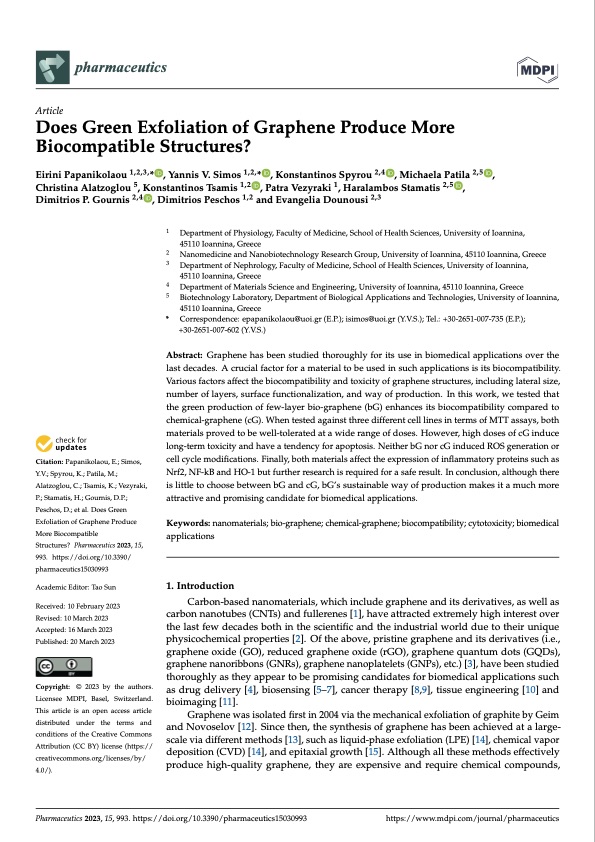
PDF Publication Title:
Text from PDF Page: 001
pharmaceutics Article Does Green Exfoliation of Graphene Produce More Biocompatible Structures? Eirini Papanikolaou 1,2,3,* , Yannis V. Simos 1,2,* , Konstantinos Spyrou 2,4 , Michaela Patila 2,5 , Christina Alatzoglou 5, Konstantinos Tsamis 1,2 , Patra Vezyraki 1, Haralambos Stamatis 2,5 , Dimitrios P. Gournis 2,4 , Dimitrios Peschos 1,2 and Evangelia Dounousi 2,3 1 2 3 4 5 * Correspondence: epapanikolaou@uoi.gr (E.P.); isimos@uoi.gr (Y.V.S.); Tel.: +30-2651-007-735 (E.P.); +30-2651-007-602 (Y.V.S.) Abstract: Graphene has been studied thoroughly for its use in biomedical applications over the last decades. A crucial factor for a material to be used in such applications is its biocompatibility. Various factors affect the biocompatibility and toxicity of graphene structures, including lateral size, number of layers, surface functionalization, and way of production. In this work, we tested that the green production of few-layer bio-graphene (bG) enhances its biocompatibility compared to chemical-graphene (cG). When tested against three different cell lines in terms of MTT assays, both materials proved to be well-tolerated at a wide range of doses. However, high doses of cG induce long-term toxicity and have a tendency for apoptosis. Neither bG nor cG induced ROS generation or cell cycle modifications. Finally, both materials affect the expression of inflammatory proteins such as Nrf2, NF-kB and HO-1 but further research is required for a safe result. In conclusion, although there is little to choose between bG and cG, bG’s sustainable way of production makes it a much more attractive and promising candidate for biomedical applications. Keywords: nanomaterials; bio-graphene; chemical-graphene; biocompatibility; cytotoxicity; biomedical applications 1. Introduction Carbon-based nanomaterials, which include graphene and its derivatives, as well as carbon nanotubes (CNTs) and fullerenes [1], have attracted extremely high interest over the last few decades both in the scientific and the industrial world due to their unique physicochemical properties [2]. Of the above, pristine graphene and its derivatives (i.e., graphene oxide (GO), reduced graphene oxide (rGO), graphene quantum dots (GQDs), graphene nanoribbons (GNRs), graphene nanoplatelets (GNPs), etc.) [3], have been studied thoroughly as they appear to be promising candidates for biomedical applications such as drug delivery [4], biosensing [5–7], cancer therapy [8,9], tissue engineering [10] and bioimaging [11]. Graphene was isolated first in 2004 via the mechanical exfoliation of graphite by Geim and Novoselov [12]. Since then, the synthesis of graphene has been achieved at a large- scale via different methods [13], such as liquid-phase exfoliation (LPE) [14], chemical vapor deposition (CVD) [14], and epitaxial growth [15]. Although all these methods effectively produce high-quality graphene, they are expensive and require chemical compounds, Department of Physiology, Faculty of Medicine, School of Health Sciences, University of Ioannina, 45110 Ioannina, Greece Nanomedicine and Nanobiotechnology Research Group, University of Ioannina, 45110 Ioannina, Greece Department of Nephrology, Faculty of Medicine, School of Health Sciences, University of Ioannina, 45110 Ioannina, Greece Department of Materials Science and Engineering, University of Ioannina, 45110 Ioannina, Greece Biotechnology Laboratory, Department of Biological Applications and Technologies, University of Ioannina, 45110 Ioannina, Greece Citation: Papanikolaou, E.; Simos, Y.V.; Spyrou, K.; Patila, M.; Alatzoglou, C.; Tsamis, K.; Vezyraki, P.; Stamatis, H.; Gournis, D.P.; Peschos, D.; et al. Does Green Exfoliation of Graphene Produce More Biocompatible Structures? Pharmaceutics2023,15, 993. https://doi.org/10.3390/ pharmaceutics15030993 Academic Editor: Tao Sun Received: 10 February 2023 Revised: 10 March 2023 Accepted: 16 March 2023 Published: 20 March 2023 Copyright: © 2023 by the authors. Licensee MDPI, Basel, Switzerland. This article is an open access article distributed under the terms and conditions of the Creative Commons Attribution (CC BY) license (https:// creativecommons.org/licenses/by/ 4.0/). Pharmaceutics 2023, 15, 993. https://doi.org/10.3390/pharmaceutics15030993 https://www.mdpi.com/journal/pharmaceuticsPDF Image | Green Exfoliation of Graphene

PDF Search Title:
Green Exfoliation of GrapheneOriginal File Name Searched:
pharmaceutics-15-00993.pdfDIY PDF Search: Google It | Yahoo | Bing
Salgenx Redox Flow Battery Technology: Power up your energy storage game with Salgenx Salt Water Battery. With its advanced technology, the flow battery provides reliable, scalable, and sustainable energy storage for utility-scale projects. Upgrade to a Salgenx flow battery today and take control of your energy future.
| CONTACT TEL: 608-238-6001 Email: greg@infinityturbine.com | RSS | AMP |